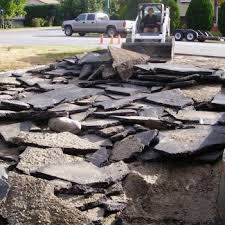
Has your asphalt driveway seen better days? Maybe it’s full of potholes and cracking that makes it hard to walk on, let alone drive on it.
Driveways aren’t just for cars. There are some 75 million driveways in the United States. Most do double duty as play areas and work spaces for all kinds of projects. Many of these asphalt driveways are showing their age, with cracks, heaving, and other signs of distress.
As you look at your crumbling asphalt driveway, you may be thinking -- It’s time to tear this out and start over.
How much does it cost to remove an asphalt driveway in Phoenix?
Hiring a company to break up and remove asphalt takes away a lot of the guesswork and hassle of doing it yourself. Not to mention, you won’t have to rent any of the heavy equipment necessary for a job this size or try to figure out how to haul away the old asphalt.
Usually, it will cost about $2.50 to $3.50 per square foot to tear up and remove asphalt from your driveway. A short driveway of about 10 feet by 20 feet or 12 feet by 25 feet will probably cost about $500 to $1,000, depending on the thickness of the asphalt and gravel base. Smaller jobs do tend to cost more per square foot.
How is an asphalt driveway demolished in Phoenix?
While it may be tempting to DIY demolishing your driveway in Phoenix, you should probably hire a professional. You will need specialized heavy equipment and haul the old asphalt off your property. These are things best left to professionals.
Usually, asphalt driveway removal is accomplished by using a jackhammer to break up the asphalt into smaller pieces. A circular saw could also be used.
The demolition will start in places where your driveway is already damaged. An excavator is used to pull up large chunks of asphalt. These large chunks are later broken apart with a saw, jackhammer, pickaxe or shovel. Manual tools are used closer to your home as to not damage structures or power lines. In places where you want to have a clean edge, a circular saw is used to cut a straight line across the asphalt.
Once all the asphalt has been broken up and dug out, it’s time to get rid of it. This is where hiring a contractor is very useful. A contractor will have the heavy duty equipment needed to haul large loads of asphalt to the recycling center.
What causes asphalt problems?
You may be looking at your asphalt thinking, how did it get like this? Here are some common asphalt problems and what causes them.
- Potholes: You probably see these on the road. Potholes are usually small and look like little bowls on the surface of your asphalt. This happens when asphalt materials have gone missing, usually due to water infiltrating the asphalt. Also, potholes can occur if poor asphalt material was used, or if it suffers from poor maintenance.
- Depressions: These are like baby potholes. These small depressions are usually noticeable after a rainy day. You’ll notice water pooling up on your asphalt where it normally doesn’t. Depressions usually occur because of poor construction or when the pavement structure below has settled.
- Raveling: You may notice the stone base of your asphalt separating from the surface of your asphalt. That’s called raveling. This problem is especially noticeable as the separation of stone from the asphalt gies it a rough texture. This happens when your driveway is constructed under bad weather conditions. Other causes include hardenting, an inferior asphalt mix, or improper compaction of the asphalt.
- Crescent-Shaped Cracking: These crescent-shaped cracks look like tears on the surface of the asphalt. Also known as slippage cracking, the cause of this kind of problem is the use of poor bonding materials underneath the surface of the asphalt.
- Alligator Cracking: This one is obvious. It looks like alligator skin. This happens in areas where the load of materials being transported or stored on the asphalt is greater than what the pavement can actually handle. This can also happen when oxidation has set in, making the asphalt surface lose its flexibility.
- Shrinkage Cracking: This looks like an even larger form of alligator cracks. This kind of cracking is caused by shrinkage, which causes the asphalt to lose its ability to bind, expand or adapt to different temperature changes.
- Reflective Cracking: Let’s say you just had your original pavement resurfaced. Then, you see the same cracking on the surface of your newly resurfaced pavement. Then you have what’s called reflective cracking. This means that the cracks on the original surface have continued on the new one.
If you are thinking about demolishing your asphalt driveway in Phoenix, you can trust the team at Joe’s Bobcat Service. We have the expertise to see your project from start to finish, with as few headaches as possible. Call (602) 780-3343 or visit our website at https://www.joesbobcatdemolition.com/request to request a quote today.
